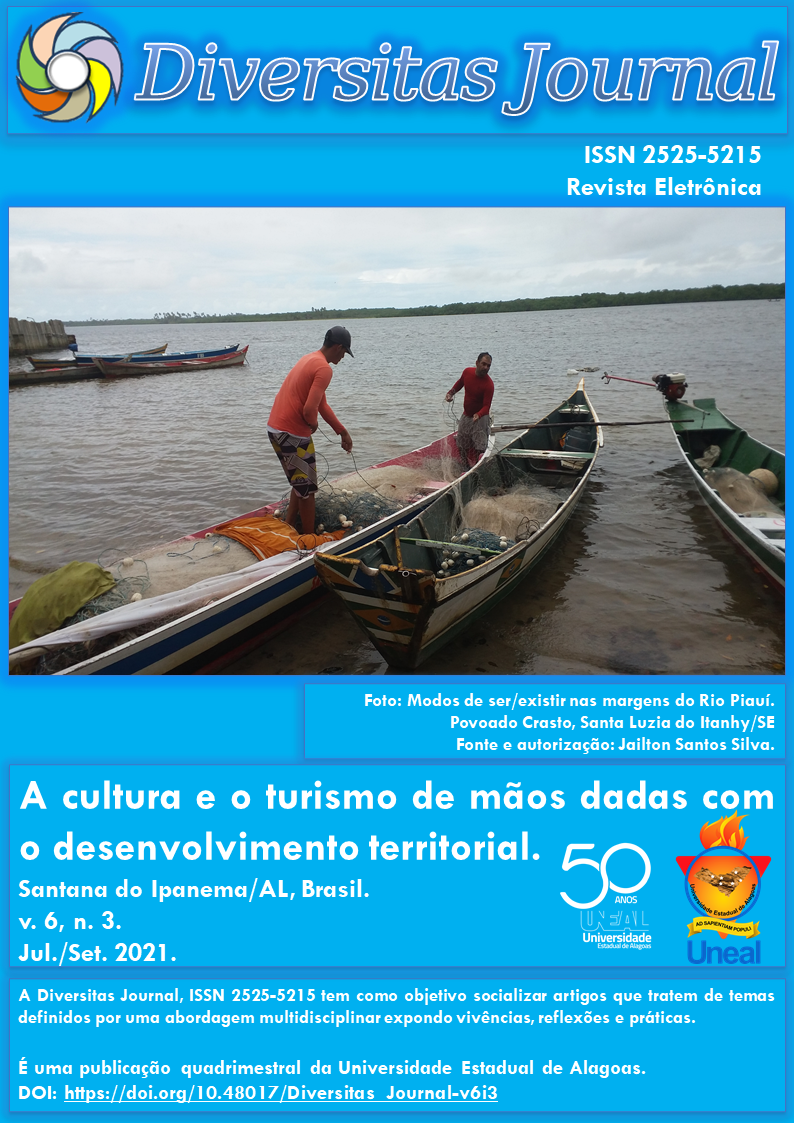Phytochemical investigation, phenol content and allelopathic potential of Croton heliotropiifolius Kunth extract
DOI:
https://doi.org/10.48017/Diversitas_Journal-v6i3-1873Resumo
RESUMO: O presente estudo envolve investigação fitoquímica, conteúdo de fenol e potencial alelopático do extrato de Croton heliotropiifolius Kunth na germinação de Digitaria insularis (L.) Fedde. Com extratos etanólicos e aquosa da folha de C. heliotropiifolius; foi realizada prospecção de metabólitos secundários e Testes de espectrofotometria ultravioleta-visível (UV-visível) para fenóis totais e flavonóides. O bioensaio de germinação foi realizado em câmara BOD (12L: 12D) com extratos vegetais a 100, 50, 25 e 10%, tendo água como controle contra sementes de D. insularis. Foram avaliados a porcentagem de germinação (G%), índice de velocidade de germinação (IVG), plântulas anormais (PAn%), comprimento de raiz e parte aérea (CR e CPA). Os extratos reduziram a germinação e o desenvolvimento das espécies-alvo indicadas por G% e IVG a partir da concentração de 10%. O mesmo ocorreu com as variáveis PAn%, CR e CPA. Em ambos os extratos foi indicada a presença de metabólitos secundários, o teor de fenol obtido foi de 0.3422 mg EAG / g para o extrato etanólico e 0.375 mg EAG / g para o extrato aquoso, para os flavonóides 0.1071 mg EQ / g no etanólico extrato e 0.0110 mg EQ / g em extrato aquoso. Os extratos demonstraram redução na germinação e alteração na fisiologia das sementes de Digitaria insularis (L.) Fedde.
PALAVRAS-CHAVE: Extratos, Metabolitos secundários, Germinação.
Métricas
Referências
ALQARAWI, Abdulaziz A. et al. Allelopathic effects of the aqueous extract of Rhazya stricta on growth and metabolism of Salsola villosa. Plant Biosystems-An International Journal Dealing with all Aspects of Plant Biology, v.152, n.6, p. 1263-1273, 2018.
ASHIQ, M.; ASLAM, Z. Weeds and weedicides. Department of Agronomy, Ayub Agricultural Research Institute, Pakistan, 2014.
BAJWA, Ali Ahsan. Sustainable weed management in conservation agriculture. Crop Protection, v. 65, p. 105-113, 2014.
BLAIR, Aaron et al. Pesticides and human health. Journal Occup Environ Medicinal, v.72, n.2, p.81–89, 2015.
CANELO, Laura IN et al. Composição química de uma população de Croton gratissimusBURCH (EUPHORBIACEAE). Química Nova, v.40, n.9, p.1035-1038, 2017.
CARVALHO, F. P. et al. The allelopathic effect of Eucalyptus leaf extract on grass forage seed. Planta Daninha, 33(2), 193-201, 2015.
COMPAGNONE, Reinaldo S. et alComposition and cytotoxic activity of essential oils from Croton matourensis and Croton micansfrom Venezuela. Records of Natural Products, v.4, n.2, 2010.
CRUZ, Cosme Damião. Genes: a software package for analysis in experimental statistics and quantitative genetics. Acta Scientiarum. Agronomy, v. 35, n. 3, p. 271-276, 2013.
DA SILVA, Ana Claudia Martins et al.Phytochemical Profile and Evaluation of the Allelopathic Effect of the Aqueous Extract of Fimbristylis miliacea(L.) Vahl (Cyperaceae). Journal of Agricultural Studies, 2020a.
DA SILVA, Ana Claudia Martins et al. Phytochemical Profile and Evaluation of the Allopathic Effect of Three Species of the Genus Cyperus(Cyperaceae). Journal of Agricultural Studies, v.8, n.3,p.569-584, 2020b.
DA SILVA, Ueveton Pimentel et al. Allelopathic activity and chemical constituents of extracts from roots of Euphorbia heterophyllaL. Natural product research, v.33, n.18, p.2681-2684, 2019.
DE OLIVEIRA, Letícia Freire et al. Chemical composition of the volatile oil of Croton glandulosus Linnaeus and its allelopathic activity. Natural Product Research, p.1-4, 2020.
DE SOUSA, José Israel Macedo et al. O gênero Croton L.(Euphorbiaceae) no Horto Florestal Olho D’Água da Bica, Cuité/PB. Agropecuária científica no semiárido, v.10, n.3, p. 01-07, 2014.
DE VASCONCELOS, Ana Karina Moreira et al. A ascensão da odontogeriatria no brasil através do panorama de suas publicações. Revista de Pesquisa: Cuidado é Fundamental Online, v. 10, n. 3, p. 165-171, 2018.
EKWEALOR, K. U. et al. Economic Importance of Weeds: A Review. Asian Plant Research Journal, p.1-11, 2019.
EL-ROKIEK, Kowthar G. et al. Allelopathic effect of the two medicinal plants Plectranthus amboinicus(Lour.) and Ocimum basilicum L. on the growth of Pisum sativumL. and associated weeds. Middle East Journal of Agriculture Research, v.7, n.3, p. 1146-1153, 2018.
ERVIN, David; JUSSAUME, Ray. Integrating social science into managing herbicide-resistant weeds and associated environmental impacts. Weed Science, v. 62, n. 2, p. 403-414, 2014.
ESPEJO-GARCIA, Borja et al. Towards weeds identification assistance through transfer learning. Computers and Electronics in Agriculture, v. 171, p. 105306, 2020.
FAN, Peihong; HOSTETTMANN, Kurt; LOU, Hongxiang. Allelochemicals of the invasive neophyte Polygonum cuspidatum Sieb. & Zucc.(Polygonaceae). Chemoecology, v. 20, n. 3, p. 223-227, 2010.
FAVARETTO, Adriana; SCHEFFER-BASSO, Simone M.; PEREZ, Naylor B. Allelopathy in Poaceae species present in Brazil. A review. Agronomy for Sustainable Development, v. 38, n. 2, p. 1-12, 2018.
FIORENZA, Mireli et al. Análise fitoquímica e atividade alelopática de extratos de Eragrostis plana Nees (capim-annoni). Iheringia. Série Botânica., v. 71, n. 2, p. 193-200, 2016.
GILANI12, SYED ABDULLAH et al. Phytotoxic studies of medicinal plant species of Pakistan. Pak. J. Bot, v. 42, n. 2, p. 987-996, 2010.
HAKANSSON, Sigurd. Weeds and Weed Management on Arable Land An Ecological Approach. CABI, 2003.
IMATOMI, Maristela; NOVAES, Paula; GUALTIERI, Sonia Cristina Juliano. Interspecific variation in the allelopathic potential of the family Myrtaceae. Acta Botanica Brasilica, v. 27, n. 1, p. 54-61, 2013.
JABRAN, Khawar et al. Allelopathy for weed control in agricultural systems. Crop protection, v. 72,p. 57-65, 2015.
JABRAN, Khawar. Allelopathy: introduction and concepts. In: Manipulation of Allelopathic Crops for Weed Control.Springer, Cham, 2017. p. 1-12.
LADHARI, A. et al. Phytotoxic effects of Mediterranean plants extracts on lettuce, tomato and onion as possible additive in irrigation drips. Allelopathy Journal, v. 44, n. 2, p. 233-244, 2018.
LI, Zhao-Hui et al. Phenolics and plant allelopathy. Molecules, v. 15, n. 12, p. 8933-8952, 2010.
LUCENA, M. F. A. Estudos taxonômicos do gênero CrotonL. (Crotonoideae –Euphorbiaceae) nas zonas do Litoral e da Mata do estado de Pernambuco –Brasil. 2000. 136 f. Dissertação (Mestrado em Botânica) -Universidade Federal Rural de Pernambuco, Recife.
Lucena, M.F.A. 2001. Estudos taxonômicos do gênero Croton L. (Crotonoideae –Euphorbiaceae) nas zonas do litoral e da Mata do estado de Pernambuco –Brasil. 136 f. Dissertação de Mestrado, Universidade Federal Rural de Pernambuco, Recife.
MA, Shujie et al. Potent herbicidal activity of Sapindus mukorossi Gaertn. against Avena fatua L. and Amaranthus retroflexusL. Industrial Crops and Products, v. 122, p. 1-6, 2018.
MA, Yuan et al. Allelopathic potential of Jatropha curcas. African Journal of Biotechnology, v. 10, n. 56, p. 11932-11942, 2011.
MAGUIRE, James D. Speed of germination—Aid in selection and evaluation for seedling emergence and vigor 1. Crop science, v. 2, n. 2, p. 176-177, 1962.
MARASCHIN-SILVA, Fabiana; AQÜILA, Maria Estefânia Alves. Potencial alelopático de espécies nativas na germinação e crescimento inicial de Lactuca sativaL.(Asteraceae). Acta Botanica Brasilica, v. 20, n. 1, p. 61-69, 2006.
MATOS, José Maurício Duarte; MATOS, Maria Elisa Oliveira. Farmacognosia: curso teórico e prático. In: Farmacognosia: curso teórico e prático. 1989. p. 245-245.
MOSS, S. R. Integrated weed management (IWM): will it reduce herbicide use?. Communications in agricultural and applied biological sciences, v. 75, n. 2, p. 9-17, 2010.
MOŻDŻEŃ, Katarzyna et al. Influence of allelopathic activity of Galinsoga parviflora Cav. and Oxalis fontana Bunge on the early growth stages of cultivars Raphanus sativus L. var. radicula Pers. Biologia,v. 73, n. 12, p. 1187-1195, 2018.
MUZELL TREZZI, Michelangelo et al. Allelopathy: driving mechanisms governing its activity in agriculture. Journal of Plant Interactions, v. 11, n. 1, p. 53-60, 2016.
OLIVEIRA, Andreya Kalyana; COELHO, Maria de Fatima Barbosa; DIÓGENES, Francisco Esio Porto. ALLELOPATHIC ACTIVITY OF Amburana cearensis SEED EXTRACTS ON MELON EMERGENCE. Revista Caatinga, v. 33, n. 1, p. 274-280, 2020.
PAYO HILL, Armando et al. Tamizaje fitoquímico preliminar de especies del género Croton L. Revista Cubana de Farmacia, v. 35, n. 3, p. 203-206, 2001.
PEREIRA, J. C. et al. Allelopathic Potential of Ethanolic Extract and Phytochemical Analysis of Paspalum maritimum Trind. Planta Daninha, v. 37, 2019.
PERRY, Laura G.; CRONIN, Spencer A.; PASCHKE, Mark W. Native cover crops suppress exotic annuals and favor native perennials in a greenhouse competition experiment. Plant Ecology, v. 204, n. 2, p. 247-259, 2009.
RABÊLO, Gabriel Oliveira et al. Potencial alelopático de Bidens pilosa L. na germinação e no desenvolvimento de espécies cultivadas. Revista Científica da Faminas, v. 4, n. 1, 2016.
RANDAU, K. P. et al. Pharmacognostic study of Croton rhamnifolius HBK and Croton rhamnifolioides Pax & Hoffm.(Euphorbiaceae). Revista Brasileira de Farmacognosia, v. 14, n. 2, p. 89-96, 2004.
RICE, E.L. Allelopathy, 2nd edn Academic Press. New York, USA.1984.
SALATINO, Antonio; SALATINO, Maria L. Faria; NEGRI, Giuseppina. Traditional uses, chemistry and pharmacology of Croton species (Euphorbiaceae). Journal of the Brazilian chemical society, v. 18, n. 1, p. 11-33, 2007.
SCAVO, Aurelio; RESTUCCIA, Alessia; MAUROMICALE, Giovanni. Allelopathy: principles and basic aspects for agroecosystem control. In: Sustainable Agriculture Reviews 28. Springer, Cham, 2018. p. 47-101.
SCHERER, R.; GODOY, H. T. Effects of extraction methods of phenolic compounds from Xanthium strumariumL. and their antioxidant activity. Revista Brasileira de Plantas Medicinais, v. 16, n. 1, p. 41-46, 2014.
SILVA, Juliana Santos et al. Sinopse das espécies de Croton L.(Euphorbiaceae) no estado de Pernambuco, Brasil. Acta Botanica Brasilica, v. 24, n. 2, p. 441-453, 2010.
SISODIA, Swapnal; SIDDIQUI, M. Badruzzaman. Allelopathic effect by aqueous extracts of different parts of Croton bonplandianumBaill. on some crop and weed plants. Journal of Agricultural Extension and Rural Development, v. 2, n. 1, p. 022-028, 2010.
ŚLIWIŃSKI M, SZCZĘŚNIAK E. Chwasty pól uprawnych. Zielona Planeta, v.4, n.103, p.14–16, 2012.
SODRÉ, Rodolfo Carneiro; DA SILVA, Marcos José. O gênero Croton L.(Euphorbiaceae ss–Crotonoideae) na Floresta Nacional de Silvânia, Goiás, Brasil. Iheringia. Série Botânica., v. 70, n. 1, p. 89-104, 2015.
SOTI, Pushpa; GOOLSBY, John A.; RACELIS, Alexis. Agricultural and environmental weeds of South Texas and their management. Subtropical Agriculture and Environments, v. 71, 2020.
DE SOUZA, Letiele Bruck et al. Quantificação de flavonóides nas raizes de Urera bacciferagaudich (Urticaceae). Revista Contexto & Saúde, v. 11, n. 20, p. 1287-1290, 2011.
SSALI, Fredrick; MOE, Stein R.; SHEIL, Douglas. The differential effects of bracken (Pteridium aquilinum(L.) Kuhn) on germination and seedling performance of tree species in the African tropics. Plant Ecology, v. 220, n. 1, p. 41-55, 2019.
TABAGLIO, Vincenzo et al. Alternative weed control using the allelopathic effect of natural benzoxazinoids from rye mulch. Agronomy for sustainable development, v. 28, n. 3, p. 397-401, 2008.
Taiz L, Zeiger E. Fisiologia vegetal 5ªed. Porto Alegre: Editora Artmed.2015.
WANG, Xi et al. Herbicidal activity of mustard seed meal (Sinapis alba ‘IdaGold’and Brassica juncea ‘Pacific Gold’) onweed emergence. Industrial Crops and Products, v. 77, p. 1004-1013, 2015.
WEIR, Tiffany L.; PARK, Sang-Wook; VIVANCO, Jorge M. Biochemical and physiological mechanisms mediated by allelochemicals. Current opinion in plant biology, v. 7, n. 4, p. 472-479, 2004.
ZHANG, Feng-Juan et al. Influence of coastal plain yellowtops (Flaveria bidentis) residues on growth of cotton seedlings and soil fertility. Archives of Agronomy and Soil Science, v. 58, n. 10, p. 1117-1128, 2012.
ARAÚJO, Claudia Lysia de O.; NICOLI,Juliana Silva. Uma revisão bibliográfica das principais demências que acometem a população brasileira. Revista Kairós: Gerontologia, v. 13, n. 1, 2010.
BAGNE, Bruna Mantovani et al. Quality Of Life Of Alzheimer Patients' Caregivers [qualidade De Vida Do Cuidador Do Portador De Doença De Alzheimer]. Revista Enfermagem, 2014.
BURLÁ, Claudia et al. Envelhecimento e doença de Alzheimer: reflexões sobre autonomia e o desafio do cuidado. Revista Bioética, v. 22, n. 1, p. 85-93, 2014.
CAMPOS, Camila Heitor; RIBEIRO, Giselle Rodrigues; RODRIGUES GARCIA, Renata Cunha Matheus. Oral health‐related quality of life in mild Alzheimer: patient versus caregiver perceptions. Special Care in Dentistry, v. 36, n. 5, p. 271-276, 2016.
ELLEFSEN, Birita S. et al. Indicators for root caries in Danish persons with recently diagnosed Alzheimer’s disease. Gerodontology, v. 29, n. 3, p. 194-202, 2012.
FROTA, Bruna Marjorie Dias et al. Evaluation of oral conditions in patients with neurodegenerative diseases treated in geriatric centers. RGO-Revista Gaúcha de Odontologia, v. 64, n. 1, p. 17-23, 2016.
GOOZEE, K. G. et al. Examining the potential clinical value of curcumin in the prevention and diagnosis of Alzheimer’s disease. British Journal of Nutrition, v. 115, n. 3, p. 449-465, 2016.
GURAV, Abhijit N. Alzheimer's disease and periodontitis-an elusive link. Revista da Associação Médica Brasileira, v. 60, n. 2, p. 173-180, 2014.
HATIPOGLU, Müjgan Güngör; KABAY, Sibel Canbaz; GÜVEN, Gül. The clinical evaluation of the oral status in Alzheimer‐type dementia patients. Gerodontology,v. 28, n. 4, p. 302-306, 2011.
MACHADO, Miriane Carneiro; LOPES, Graziele Honorio; MARCHINI, Leonardo. Oral health of Alzheimer's patients in São José dos Campos, Brazil. Geriatrics & gerontology international, v. 12, n. 2, p. 265-270, 2012.
MANCINI, M. et al. Oral health in Alzheimer's disease: a review. Current Alzheimer Research, v. 7, n. 4, p. 368-373, 2010.
MARTANDE, Santosh S. et al. Periodontal health condition in patients with Alzheimer’s disease. American Journal of Alzheimer's Disease & Other Dementias®,v. 29, n. 6, p. 498-502, 2014.
MENDES, Karina Dal Sasso; SILVEIRA, Renata Cristina de Campos Pereira; GALVÃO, Cristina Maria. Revisão integrativa: método de pesquisa para a incorporação de evidências na saúdee na enfermagem. Texto & contexto-enfermagem, v. 17, n. 4, p. 758-764, 2008.
MELOTO, Carolina Beraldo et al. Dental practice implications of systemic diseases affecting the elderly: a literature review. Brazilian Journal of Oral Sciences, p. 1691-1699, 2016.
MIRANDA, Alexandre Franco et al. Doença de Alzheimer: características e orientações em odontologia.Revista Longeviver, n. 6, 2011.
NITZSCHE¹, Bárbara Oliveira; DE MORAES¹, Helena Providelli; JÚNIOR, Almir Ribeiro Tavares. Doença de Alzheimer: novas diretrizes para o diagnóstico. Rev Med Minas Gerais,v. 25, n. 2, p. 237-243, 2015.
ORTEGA-MARTÍNEZ, Jordi et al. Alzheimer's disease: oral manifestations, treatment and preventive measures. Journal of Oral Research, v. 3, n. 3, p. 184-189, 2014.
RIBEIRO, Giselle Rodrigues et al. Oral health of the elderly with Alzheimer's disease. Oral surgery, oral medicine, oral pathology and oral radiology, v. 114, n. 3, p. 338-343, 2012.
ROLIM, Thaís de Souza et al. Evaluation of patients with Alzheimer's disease before and after dental treatment. Arquivos de Neuro-psiquiatria, v. 72, n. 12, p. 919-924, 2014.
SINGHRAO, Sim K. et al. Oral inflammation, tooth loss, risk factors, and association with progression of Alzheimer's disease. Journal of Alzheimer's Disease, v. 42, n. 3, p. 723-737, 2014.
SIQUEIRA, Silvia Regina Dowgan T. de et al. Oral infections and orofacial pain in Alzheimer's disease: case report and review. Dementia & neuropsychologia, v. 4, n. 2, p. 145-150, 2010.
SOBRAL, Margarida; PESTANA, Maria Helena; PAÚL, Constança. Cognitive reserve and the severity of Alzheimer’s disease. Arquivos de neuro-psiquiatria, v. 73, n. 6, p. 480-486, 2015.
TURNER, Lena N. et al. Drug therapy in Alzheimer disease: an update for the oral health care provider. Oral Surgery, Oral Medicine, Oral Pathology, Oral Radiology, and Endodontology, v. 106, n. 4, p. 467-476, 2008.
TORRES, Bianca et al. Facial expression recognition in Alzheimer’s disease: a longitudinal study. Arquivos de Neuro-psiquiatria, v. 73, n. 5, p. 383-389, 2015.
VENTURA, Hemmily Nóbrega et al. Saúde do idoso com doença de Alzheimer: revisão integrativa. Rev. pesqui. cuid. fundam.(Online), p. 941-944, 2018.
WARMLING, Alessandra Martins Ferreira; DOS SANTOS, Silvia Maria Azevedo; DE MELLO, Ana Lúcia Schaefer Ferreira. Estratégias de cuidado bucal para idosos com Doença de Alzheimer no domicílio.Revista Brasileira de Geriatria e Gerontologia, v. 19, n. 5, p.851-860, 2016.
WILSON, Rozanne et al. Quantitative analysis of formal caregivers’ use of communication strategies while assisting individuals with moderate and severe Alzheimer's disease during oral care. Journal of communication disorders, v. 46, n. 3, p. 249-263, 2013.
Downloads
Publicado
Como Citar
Edição
Seção
Licença
Copyright (c) 2021 Chryslane Barbosa da Silva, Kelly Barbosa da Silva, Antônio Euzébio Goulart Santana, Aldenir Feitosa dos Santos, João Gomes da Costa, Lígia Sampaio Reis

Este trabalho está licenciado sob uma licença Creative Commons Attribution 4.0 International License.
O periodico Diversitas Journal expressa que os artigos são de unica responsabilidade dos Autores, conhecedores da legislação Brasileira e internacional. Os artigos são revisados pelos pares e devem ter o cuidado de avisar da possível incidencia de plagiarismo. Contudo o plagio é uma ação incontestavel dos autores. A Diversitas Journal não publicará artigos com indicios de Plagiarismos. Artigos com plagios serão tratados em conformidade com os procedimentos de plagiarismo COPE.
A violação dos direitos autorais constitui crime, previsto no artigo 184, do Código Penal Brasileiro:
“Art. 184 Violar direitos de autor e os que lhe são conexos: Pena – detenção, de 3 (três) meses a 1 (um) ano, ou multa. § 1o Se a violação consistir em reprodução total ou parcial, com intuito de lucro direto ou indireto, por qualquer meio ou processo, de obra intelectual, interpretação, execução ou fonograma, sem autorização expressa do autor, do artista intérprete ou executante, do produtor, conforme o caso, ou de quem os represente: Pena – reclusão, de 2 (dois) a 4 (quatro) anos, e multa.”


















